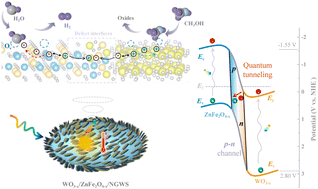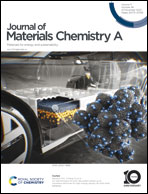Unraveling the role of surface and interfacial defects in hydrogen production to construct an all-in-one broken-gap photocatalyst†
Abstract
Broken-gap heterojunctions are rarely used as photocatalysts due to their non-overlapping bandgap, which is a barrier to optimal charge carrier separation and higher photocatalytic efficiency. Based on our observations of higher charge carrier separation, light-harvesting ability, and good surface reaction, we show that a defect-rich broken-gap heterojunction can be used as an all-in-one photocatalyst. Depending on their localization (interface or surface), experimental characterization supported by DFT calculations evidence that defects facilitate photogenerated charge separation via efficient band-to-band quantum tunneling to form a type B heterojunction without adding bias voltage, boost the dissociation and activation of adsorbed water molecules, and induce a photothermal effect. The defect-rich broken-gap heterojunction WO3−x/ZnFe2O4−x grown on upconversion luminescent particles unexpectedly exhibited a remarkable H2 generation rate of 972.8 μmol g−1 h−1 for noble metals and cocatalyst-free photocatalysts. Such defect-rich broken-gap heterostructures offer an innovative solution, as they can function as an all-in-one heterojunction photocatalyst for solar-energy conversion.



 Please wait while we load your content...
Please wait while we load your content...